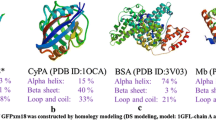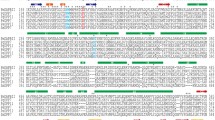Abstract
Mammalian serine proteases such as the chromosome 14 (Homo sapiens, Mus musculus) located granzymes, chymases, cathepsin G, and related enzymes including duodenase collectively represent a special group within the chymotrypsin family which we refer to here as “granases”. Enzymes of this group have lost the ancient active-site disulfide bond Cys191-Cys220 (bovine chymotrypsinogen A numbering) which is strongly conserved in classic serine proteases such as pancreatic, blood coagulation, and fibrinolysis proteases and others (granzymes A, M, K and leukocyte elastases). We sequenced the cDNA encoding bovine (Bos taurus) duodenase, a granase with unusual dual trypsin-like and chymotrypsin-like specificity. The sequence revealed a 17-residue signal peptide and two-residue (GlyLys) activation peptide typical for granases. Production of the mature enzyme is apparently accompanied by further proteolytic processing of the C-terminal pentapeptide extension of duodenase. Similar C-terminal processing is known for another dual-specific granase, human cathepsin G. Using phylogenetic analysis based on 39 granases we retraced the evolution of residues 189 and 226 crucial for serine protease primary specificity. The analysis revealed that while there is no obvious link between mutability of residue 189 and the appearance of novel catalytic properties in granases, the mutability of residue 226 evidently gives rise to different specificity subgroups within this enzyme group. The architecture of the extended substrate-binding site of granases and structural basis of duodenase dual specificity based on molecular dynamic method are discussed. We conclude that the marked selectivity of granases that is crucial to their role as regulatory proteases has evolved through the fine-tuning of specificity at three levels— primary, secondary, and conformational.
Similar content being viewed by others
Abbreviations
- MCP:
-
mast cell protease
- GLP:
-
granzyme-like protein
- NKP:
-
natural killer protease
- HLE:
-
human leukocyte elastase (medullasin)
- PRN:
-
human leukocyte protease 3 (myeloblastin)
- ChlP:
-
chymase-like protease
REFERENCES
Rawlings, N. D., and Barrett, A. J. (1993) Biochem. J., 290, 205–218.
Barrett, A. J., and Rawlings, N. D. (1998) in Handbook of Enzymes (Woessner, J. F., ed.) Academic Press, London, pp. 2–16.
Trapani, A. G. (2001) Genome Biol., 2, 3014.1–3014.7.
Zamolodchikova, T. S., Sokolova, E. A., and Smirnova, E. V. (2003) Biochemistry (Moscow), 68, 309–316.
Wouters, M. A., Liu, K., Riek, P., and Husain, A. (2003) Mol. Cell, 12, 343–354.
Zamolodchikova, T. S., Vorotyntseva, T. I., Nazimov, I. V., and Grishina, G. A. (1995) Eur. J. Biochem., 227, 873–879.
Zamolodchikova, T. S., Sokolova, E. A., Alexandrov, S. L., Mikhaleva, I. I., Prudchenko, I. A., Morozov, I. A., Kononenko, N. V., Mirgorodskaya, O. A., Da, U., Larionova, N. I., Pozdnev, V. F., Ghosh, D., Duax, W. L., and Vorotyntseva, T. I. (1997) Eur. J. Biochem., 249, 612–621.
Pemberton, A. D., Zamolodchikova, T. S., Scudamore, C. L., Chilvers, E. R., Miller, H. R., and Walker, T. R. (2002) Eur. J. Biochem., 269, 1171–1180.
McAleese, S. M., Pemberton, A. D., McGrath, M. E., Huntley, J. F., and Miller, H. R. P. (1998) Biochem. J., 333, 801–809.
Zamolodchikova, T. S., Sokolova, E. A., Lu, D., and Sadler, E. (2000) FEBS Lett., 466, 295–299.
Shechter, I. V., and Berger, A. C. (1967) Biochem. Biophys. Res. Commun., 27, 157–162.
Pletnev, V. Z., Zamolodchikova, T. S., Pangborn, W. A., and Duax, W. L. (2000) Prot. Struct. Funct. Genet., 41, 8–16.
Chomezynski, P., and Sacchi, N. (1987) Analyt. Biochem., 162, 156–159.
Guex, N., and Peitsch, M. C. (1997) Electrophoresis, 18, 2714–2723.
Ruzheinikov, S. N., Popov, M. E., and Kashparov, I. V. (2002) Bioorg. Khim., 28, 28–37.
Marelius, J., Kolmodin, K., Feierberg, I., and Aqvist, J. Q. (1999) J. Mol. Graph. Model., 16, 213–225.
Ryckaert, J. P., Ciccotti, G., and Berendsen, H. J. C. (1977) J. Comp. Phyl., 23, 327–341.
Lee, F. S., and Warshel, A. (1992) J. Chem. Phys., 97, 3100–3107.
Berendsen, H. J. C., Postma, J. P. M., Gunsteren, W. F., DiNola, A., and Haak, J. R. (1984) J. Chem. Phys., 81, 3684–3690.
Humphrey, W., Dalke, A., and Schulten, K. (1996) J. Mol. Graph., 14, 33–38.
Salvesen, G., and Enghild, J. J. (1990) Biochemistry, 29, 5304–5308.
Hof, P., Mayr, I., Huber, R., Korzus, E., Potemba, J., Travis, J., Powers, J. C., and Bode, W. (1996) EMBO J., 15, 5481–5491.
Pereira, P. J. B., Wang, Z. M., Rubin, H., Huber, R., Bode, W., Schechter, N. M., and Strobl, S. (1999) J. Mol. Biol., 286, 163–173.
Perona, J. J., Hedstrom, L., Rutter, W. J., and Fletterick, R. J. (1995) Biochemistry, 34, 1489–1499.
Waugh, S. M., Harris, J. L. Fletterick, R., and Craik, C. S. (2000) Nat. Struct. Biol., 7, 762–765.
Page, R. D. M., and Holmes, E. C. (2000) in Molecular Evolution: a Phylogenetic Approach, Blackwell Science, London, pp. 135–171.
Rypniewski, W. R., Perrakis, A., Vorgias, C. E., and Wilson, K. S. (1994) Protein. Eng., 7, 57–64.
Kam, C. M., Hudig, D., and Powers, J. C. (2000) Biochim. Biophys. Acta, 1477, 307–323.
Ewoldt, G. R., Smyth, M. J., Darcy, P. K., Harris, H. L., Craik, C. S., Horowitz, B., Woodard, S. L., Powers, J. C., and Hudig, D. (1997) J. Immunol., 158, 4574–4583.
Grigorenko, V. G., Yarovoi, S. V., Paulauskaite, R., and Amerik, A. Yu. (1994) FEBS Lett., 342, 278–280.
Edwards, K. M., Kam, Ch.-M., Powers, J. C., and Trapani, J. A. (1999) J. Biol. Chem., 274, 30468–30473.
Page, R. D. M., and Holmes, E. C. (2000) in Molecular Evolution: a Phylogenetic Approach, Blackwell Science, London, pp. 11–36.
Polanovska, J., Krokoszynska, I., Czapinska, H., Watorek, W., Dadlez, M., and Otlewski, J. (1998) Biochim. Biophys. Acta, 1386, 189–198.
Craik, Ch. S., Roczniak, S., Sprang, S., Fletterick, R., and Rutter, W. (1987) J. Cell. Biol., 33, 199–211.
Smith, M. J., O’Connor, M. D., Trapani, J. A., Kershaw, M. H., and Brinkworth, R. I. (1996) J. Immunol., 156, 4174–4181.
Bode, W., Meyer, E., and Powers, J. C. (1989) Biochemistry, 28, 1951–1963.
Kunori, Y., Koizumi, M., Masegi, T., Kasai, H., Kawabata, H., Yamazaki, Y., and Fukamizu, A. (2002) Eur. J. Biochem., 269, 5921–5930.
Perona, J. J., Tsu, C. A., McGrath, M. E., Craik, C. S., and Fletterick, R. J. (1993) J. Mol. Biol., 230, 934–939.
Remington, S. J., Woodbury, R. G., Reynolds, R. A., Matthews, B. W., and Neurath, H. (1988) Biochemistry, 27, 8097–8105.
Pasternak, A., Ringe, D., and Hedstrom, L. (1999) Protein Sci., 8, 253–258.
Frigerio, F., Coda, A., Pugliese, L., Lionetti, C., Menagatti, E., Amiconi, G., Schnebli, H. P., Ascenzi, P., and Bolognesi, M. (1992) J. Mol. Biol., 225, 107–123.
Author information
Authors and Affiliations
Corresponding author
Additional information
__________
Translated from Biokhimiya, Vol. 70, No. 6, 2005, pp. 814–828.
Original Russian Text Copyright © 2005 by Zamolodchikova, Smirnova, Andrianov, Kashparov, Kotsareva, Sokolova, Ignatov, Pemberton.
Originally published in Biochemistry (Moscow) On-Line Papers in Press, as Manuscript BM04-127, September 12, 2004.
Rights and permissions
About this article
Cite this article
Zamolodchikova, T.S., Smirnova, E.V., Andrianov, A.N. et al. Cloning and Molecular Modeling of Duodenase with Respect to Evolution of Substrate Specificity within Mammalian Serine Proteases That Have Lost a Conserved Active-Site Disulfide Bond. Biochemistry (Moscow) 70, 672–684 (2005). https://doi.org/10.1007/s10541-005-0168-2
Received:
Revised:
Issue Date:
DOI: https://doi.org/10.1007/s10541-005-0168-2




